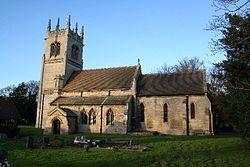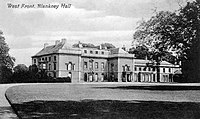Blankney
| Blankney | |
| Lincolnshire | |
|---|---|
 Church of St Oswald, Blankney | |
| Location | |
| Grid reference: | TF067602 |
| Location: | 53°7’42"N, 0°24’21"W |
| Data | |
| Population: | 251 (2011) |
| Post town: | Lincoln |
| Postcode: | LN4 |
| Local Government | |
| Council: | North Kesteven |
| Parliamentary constituency: |
Sleaford and North Hykeham |
Blankney is a village in Kesteven, the south-western part of Lincolnshire. The village is about nine miles south of the city and county town of Lincoln and nine miles north of Sleaford.
The village is in form a small stone-built estate village, built around the large estate of Blankney Hall.
The population of the civil parish at the 2011 census was 251.
Parish church
At the south end of the village is the parish church dedicated to St Oswald. The church, which was restored twice during the 19th century, has a tomb-slab to John de Glori with a bearded head looking out of a cusped opening and a sculpture by Joseph Boehm of Lady Florence Chaplin.
History

Blankney has existed from before the time of William the Conqueror: at the time of the Domesday Book of 1086, the manor belonged to the Deincourt family.
In the 15th century the estate passed through marriage to the Lovels of Titchmarsh. After the Battle of Stoke Field in 1487, all the estates of the Lovels were confiscated by Henry VII for the crown and Blankney Estate was then bought by the Thorold family. It was the Thorolds who did much to embellish the house with carved panelling of the period.
During the reign of Charles I, again through marriage it passed into the hands of Sir William Widdrington who was created Baron Widdrington of Blankney in 1643. Lord Widdrington's great grandson, William Widdrington, 4th Baron Widdrington had the indiscretion to take part in the Jacobite rising of 1715. He was captured at Preston, Lancashire|Preston, convicted of high treason and his lands were confiscated in the following year.
In 1719 Thomas Chaplin, a prominent Lincolnshire landowner, purchased the land from the Crown Commissioners for Confiscated Land, and it was to remain in the family for over two centuries. The estate owes its appearance largely to the influence of the Chaplins and their care of the land. The last Chaplin, Henry, led an extravagant lifestyle and had political ambitions; this lifestyle coupled to the falling revenues from farms led him ever into debt until finally in 1892, the estate passed to the principal mortgagee William Denison, 1st Earl of Londesborough.
At the start of the Second World War the Hall was requisitioned for use as billets for servicemen from nearby RAF stations. During 1945 it was badly damaged by fire and was then left as an empty shell before being demolished in the 1960s. All that remains today are the dilapidated remnants of the former stable block.
The Old coach-road
The Old Coach-Road was constructed from the Hall to Metheringham railway station (then called Blankney and Metheringham station) just over a mile away, around the beginning of the 20th century by Lord Londesborough. It was run through woodland both existing and newly planted and where it crossed the Blankney to Martin road, a bridge with high parapets was built to take the road over the coach-road. It was probably constructed to allow the Earl's visitors, in particular the Prince of Wales (the future King Edward VII) who used the Hall as a discreet retreat for his amorous adventures, to arrive and depart without being seen by the local populace. This coach-road still exists and although private.
Sport
Golf
Unusually, the Hall was not built within its park, the park being on the opposite side of the village's main road. Although part of the park has been lost to arable farming much of it remains as a golf course. The course was first laid out over 9 holes in 1902 by the 2nd Earl of Londesborough, in all probability at this stage for the use of himself and his guests, but in 1904 Blankney Golf Club was formed to manage the course which it continues to do today. In 1938 it was decided to extend the course to 18 holes and this extended course came into play at the start of the 1940 season.
Cricket
Blankney Cricket Club was originally formed in 1873 playing on a site in the centre of the village; it continued to flourish into the 20th century under the patronage of Lord Londesborough, who used to watch the matches from the north wing of Blankney Hall. However, after the end of the Second World War in 1945 the club went into decline and closed a few years later. In 1988 the Cricket Club was re-formed on the same site, the ground was developed, and a new clubhouse was built, opening in 1991.
Outside links
| ("Wikimedia Commons" has material about Blankney) |
